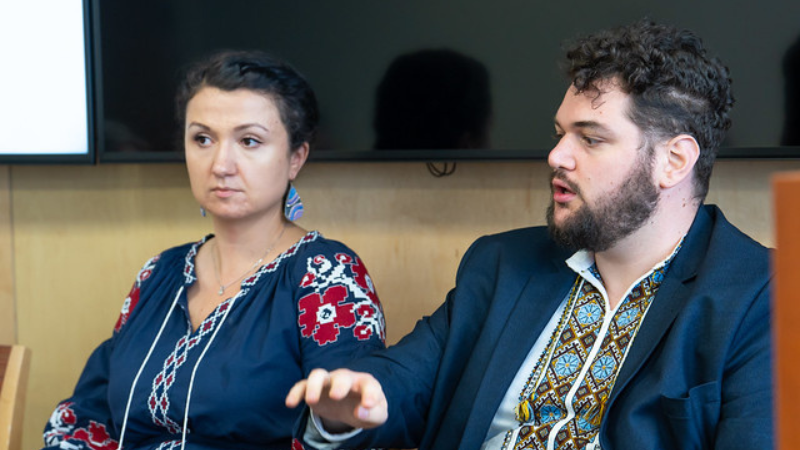
Joel Wasserman and Kateryna Sporysh Explore Ukraine’s Humanitarian Volunteering Ecosystem
By Sitara Srinivas, MALD 2025 Candidate, The Fletcher School
On September 17, 2024, the International Relations Program at Tufts University and the Ukrainian Research Institute at Harvard University hosted Joel Wasserman (A15) and Kateryna Sporysh for a conversation on “Ukraine’s Humanitarian Volunteering Ecosystem: The Grassroots Supporting Resistance and Survival.” The event offered a window into the everyday resilience of Ukrainians navigating wartime life and highlighted the critical role of grassroots organizations and civil society in sustaining Ukraine’s resistance against aggression.
As a Tufts undergraduate student studying Russian and Eastern European Studies, Wasserman watched the 2014 Euromaidan protests and the ensuing Russian aggression unfold from his dorm room in Tufts’ Latin Way residence hall. This sparked a deep interest in working for Ukraine. Since then, Wasserman has been embedded in Ukraine’s complex environment as a translator, editor, and country specialist, as well as through his marriage to Sporysh. Sporysh, a former business journalist from Kyiv, now leads Katya’s Medicine, an organization that delivers essential medicines to frontline communities and runs a water filtration initiative through the American NGO For Peace. Her journey from journalism to humanitarian work was intensely personal; she launched her organization after a family medical emergency during the war’s early days, determined to ensure critical supplies for those cut off from basic necessities.
A defining theme of the conversation was the swift mobilization of Ukrainian citizens and grassroots networks immediately following Russia’s full-scale invasion. Wasserman explained that the volunteer-driven response has been indispensable to Ukraine’s defense efforts and humanitarian support network for citizens.
“[In the early days of the war], there was a rapid and tremendous groundswell of volunteering from every person and business who could offer it. People began collecting anything they could in order to provide for refugees, civilians under fire, and the soldiers repelling the aggressor. Grannies weaved camouflaged nets. People carried out deliveries and evacuations, and of course, massive numbers of people enlisted in the armed forces in order to take up arms against the invaders,” Wasserman said.
Sporysh described the evolution of her work from a personal quest to ensure her mother had access to the medicines she needed to a broader mission of serving “the millions of Ukrainians in places where pharmacies were closed or emptied to broken supply chains.” She began using Facebook to source medicines and funds.
“This is how volunteering worked in the very early days–people posted on social media to collect medicine, food, blankets, clothes, and other necessary items. This is how Ukraine took care. It was often messy and inefficient, but that happens when everyone wants to save their country all at the same time,” she said.
Wasserman and Sporysh also explored the cultural and political dynamics underpinning Ukraine’s grassroots mobilization. Wasserman pointed to Ukraine’s decentralized, pluralistic political landscape, which has cultivated a strong civil society.
Sporysh added, “Ukraine did not grow its culture of civic activism from zero starting off on February 24, 2022. The grassroots played a tremendous role in our Revolution of Dignity on Maidan and in defending Donbas against Russian aggression. But February 24 forced every Ukrainian to see the reality of war and the danger of losing our country. It was happening to us, to our people, and to the people we love. So every Ukrainian felt the need to do something.”
The decentralized nature of grassroots organizations allowed them to reach individuals that big organizations missed and, especially, to begin work while larger humanitarian organizations were still trying to gauge the situation on the ground.
“[Even today], these [large] organizations help the people who can reach the urban centers where they work. My network of grassroots volunteers helps the people who cannot. People in the grassroots humanitarian movement focus on these people who fall through the cracks. My colleagues focus on the front line, communities close to where they live to provide aid. Nobody else will. They aren’t allowed to go. [My colleagues] will find a way, even when it’s dangerous,” Sporysh said.
Sporysh illustrated her organization’s impact through stories from individuals in frontline areas, recounting the case of Tetyana—a kindergarten teacher from Kherson Oblast who was severely injured by a landmine soon after her village’s liberation. Tetyana’s recovery depended on critical monthly deliveries from Sporysh’s network, which ensured she did not face a lethal blood clot. The network significantly improved Tetyana’s quality of life within a six-month period by procuring liver medicines, calcium tablets, special blood thinners, and a walker.
When asked about the concept of “peace with justice”, Wasserman and Sporysh reflected on its unique meaning for Ukrainians. They understood the idea as about Ukraine “being given the ability to rebuild, and not at Russia’s expense as much as possible. It meant individuals responsible being identified and facing punishment to the extent that [they]can be brought to justice.” They also added that it is the ability to go home and rebuild their lives.
The event concluded with a Q&A session, in which Wasserman and Sporysh were asked about the resilience of Ukrainian civil society, the partnership between state and grassroots efforts, and the challenges of delivering aid in Russian-occupied regions. The value of Wasserman’s and Sporysh’s work was clear, and what it meant to the war at large.
According to Wasserman, “Vladimir Putin’s most serious miscalculation in this war was his determination that Ukrainian people do not have anything worth fighting or dying for…Russia knows that this grassroots civic initiative is inimical to the goals of their war and occupation, [which are] to crush the Ukrainian spirit, eliminate the Ukrainian identity, and ultimately liquidate the Ukrainian nation.”

